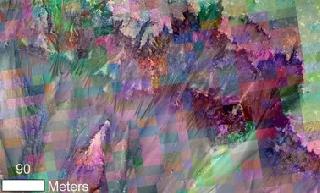
The image combines a photograph of seasonal dark flows on a Martian slope with a grid of colours based on data collected by a mineral-mapping spectrometer observing the same area. Image credit: NASA/JPL-Caltech/UA/JHU-APL
WASHINGTON (PTI): Scientists using data from NASA's Mars orbiting spacecraft have found the 'strongest indication' that liquid water could still exist on the Red Planet.
The features are dark, finger-like markings that advance down some Martian slopes when temperatures rise, researchers said.
The new clues include corresponding seasonal changes in iron minerals on the same slopes and a survey of ground temperatures and other traits at active sites.
These support a suggestion that brines with an iron-mineral antifreeze, such as ferric sulfate, may flow seasonally, though there are still other possible explanations.
Researchers call these dark flows "recurring slope lineae."
"We still don't have a smoking gun for existence of water in RSL, although we're not sure how this process would take place without water," said Lujendra Ojha, a graduate student at the Georgia Institute of Technology, Atlanta, and lead author of two new reports about these flows.
He originally discovered them in images from the High Resolution Imaging Science Experiment (HiRISE) camera on NASA's Mars Reconnaissance Orbiter.
Ojha and Georgia Tech assistant professor James Wray more recently looked at 13 confirmed RSL sites using images from the same orbiter's Compact Reconnaissance Imaging Spectrometer for Mars (CRISM) instrument.
They searched for minerals that RSL might leave in their wake as a way of understanding whether these features were water-related.
They didn't find any spectral signature tied to water or salts. But they did find distinct and consistent spectral signatures of ferric and ferrous minerals at most of the sites.
These iron-bearing minerals were more abundant or featured distinct grain sizes in RSL-related materials as compared to non-RSL slopes.
"Just like the RSL themselves, the strength of the spectral signatures varies according to the seasons. They're stronger when it's warmer and less significant when it's colder," Ojha said.
One possible explanation for these changes is a sorting of grain sizes, such as removal of fine dust from the surface, which could result from either a wet process or dry one.
Two other possible explanations are an increase in the more-oxidised (ferric) component of the minerals, or an overall darkening due to moisture. Either of these would point to water, even though no water was directly detected.
The spectral observations might miss the presence of water, because the dark flows are much narrower than the area of ground sampled with each CRISM reading, researchers said.
Also, the orbital observations have been made only in afternoons and could miss morning moisture.
These findings are published in the journal Geophysical Research Letters.
 Previous Article
Previous Article Next Article
Next Article












The Indian Air Force, in its flight trials evaluation report submitted before the Defence Ministry l..
view articleAn insight into the Medium Multi-Role Combat Aircraft competition...
view articleSky enthusiasts can now spot the International Space Station (ISS) commanded by Indian-American astr..
view article